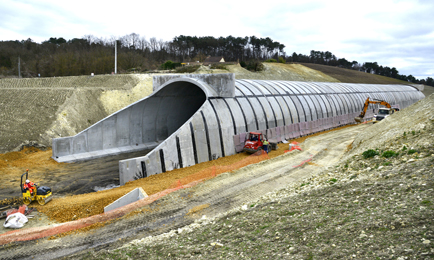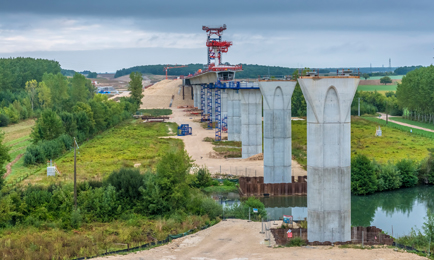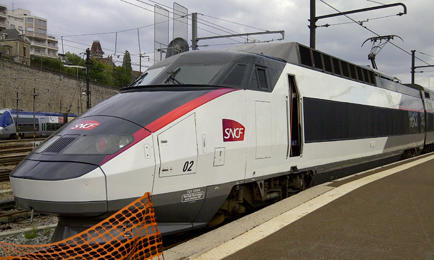From the US to the UK to India, politicians and engineers are debating the pros and cons of high speed rail as countries look to boost their economy’s prosperity. However, if you are looking for a model of how to do high speed rail right, then you don't have to look much further than France.
Since the first LGV (ligne à grande vitesse) line opened between Paris and Lyon in 1981, the TGV (train à grande vitesse) trains have become an increasingly familiar sight speeding at 300km/hr through the French countryside. Although the French may not have been the very first with high speed rail, they have successfully pioneered its profitable domestic use.
Over the years, France’s national rail company SNCF has continued to refine and develop the TGV. There are now 10 high speed lines in France. Despite a long recession, the French government continues to plough the high speed furrow - more than 2,000km of new line is planned to have been opened by the end of this decade.
Of the three projects under construction in France at the moment, the 302 km line extension between Tours and Bordeaux on the western side of the country is considered the most important. The “Sud Europe Atlantique” line will reduce the journey between Paris and Bordeaux by one hour to just over two hours. According to French infrastructure provider Réseau Ferré de France (RFF) the line is the biggest construction site in Europe and will have employed 4,500 workers by the time it is opened in 2017.
Construction of the Sud Europe Atlantique line started in 2012. As it scythes through the countryside the line requires some 285 road and rail bridges, five underpasses - the longest of which is two kilometres - 15 valley-spanning viaducts, seven tunnels and multiple booms, flyovers and culverts, to be built. It's estimated some 68 million cubic metres of dirt will be moved and 91,500 tonnes of steel rail laid.


 The extension to the Atlantique line in France is said to be the biggest construction site in Europe
The extension to the Atlantique line in France is said to be the biggest construction site in Europe
The project notable is notable for more than its grand scale. Its €7.8 billion cost is being met for the first time in the French rail sector by a “Private Public Partnership”, a funding model that shares cost and risk between the government and private sector. Once built by Cosea, a subsidiary of construction firm Vinci, the line will be run by a different subsidiary of Vinci for fifty years.
As well as the politics and earth being moved for the TGV, the habitat of 220 endangered species is under threat. French engineers construct small tunnels under the railway line for the wildlife to cross the tracks, a common practice, says Hugh Rochford, technical coordinator at French train operator SNCF’s Infrastructure Department. “We design tunnels specifically so the animals can cross safely. The environment is a very important influence on the design, and the impact of the railways is monitored by experts. We even build tunnels for frogs,” he says.
The effect a high speed railway line and high speed trains have on the local fauna and flora is just one of many physical environment “interface” challenges engineers face when designing, building and running a high speed rail line. French rail engineers have developed tried and tested techniques to solve the problems at this interface over the last thirty years.
Compared to conventional rail, a high speed train creates extra downward stress, has a tendency to grip the rail in front of the wheel and has a different repulsion of the vibrations inside the rail. It also generates a strong pressure wave in the air that can create discomfort for the passengers and safety issues. Rochford says: “When the train enters the tunnel high pressure is created all over the train. When it exits a strong pulse wave is transmitted in all directions.You can pressurise the train or you can adapt the infrastructure to deal with the effect. We try to do both.”
Another corollary of the extra speed is the strong movement of air created under the train, which creates a blast effect that can flick stones, ballast, debris, or ice and snow into the air. This can damage both the underside of the train or other passing trains. If ballast smashes onto the rail under the wheel it can create a defect that eventually leads to a broken rail. Rochford says: “High speed rail doesn't wear the same way as conventional rail. The rail stress on high speed lines is specific, since the same type of trains run at high speed all the time. This amplifies any defect in the track very quickly.”
The problem was most recently apparent when German ICE trains entered the French Eastern high speed line. The German trains were designed to run on concrete slab tracks. “The resulting blast was tremendous and the tracks had to be cleaned. They did not make any friends on the maintenance side,” says Rochford. “In the end the German trains had to be modified and we lowered the level of the ballast.
“You have to know a lot about these effects or you will have problems. Preventive measures have to be taken, ensuring a low ballast profile and brushing the rails afterwards as well as maintaining defences around the tracks.”
Ballast is used instead of concrete because SNCF have found that up to speeds of 320km/hr it makes maintenance easier, as corrections can be made locally. Monobloc sleepers with pads underneath are used because they have a greater acceptance of the load and offer more contact surface with the ballast. This helps to extend the lifetime of the ballast, and dampening of the track and grounding rail are required less. The pads reduce noise and vibration, improve track quality and stiffness and reduce maintenance costs, says Rochford.
 The TGV in its latest renovated incarnation for the northern high speed line
The TGV in its latest renovated incarnation for the northern high speed line
There are other challenges presented by the TGV. The trains, says Rochford, are relatively lightweight. It was soon discovered that in some places they can be tilted by strong winds. Wind speed detectors were therefore installed in high risk places, such as bridges. If the winds get too strong the trains are slowed down or stopped completely. Another major difference related to the weight is traction and braking.
Rochford says: “TGVs are not designed to go on steep hills. It can take several kilometers for the train to stop and it depends a lot on the gradient. If you are going downhill it will take a long time. If it has to stop on a hill, there is a strong probability that it will not be able to restart. The TGV is built for speed, it’s not a freight train.”
Jocelyn Gallou, international development manager of SNCF INFRA Projects, says that care also has to be taken over the design of line structures like the bridges. He says: “High speed needs a very efficient technical track to ensure your ballast is very soft. The bridges are very high, so you can’t have a high shock between the ballast and the bridge when the train runs. This is very different than conventional line.”
TGVs therefore have better suspension than conventional trains, to offer more comfort. They are also articulated differently than most other trains, with adjacent cars resting on a common two-axle truck. Effectively the TGV’s structure is a single, stiff, trainset that does not twist. This means that if it derails there is a higher chance it will remain straight, which has added to its excellent safety record over the decades. There has not been one fatality as a result of a TGV accident during the last 30 years.
Gallou says that engineers consider “holistic system challenges of the rail system” during feasibility studies and throughout construction. Extensive computer modelling and simulation is done to assess if the design solutions are feasible and agree with the original specifications. The simulations include modelling the dynamic behaviour of the particulate phenomenon of the flying ballast around the rails and bottom of the trains, the behaviour of the pantograph and the catenary and the rail and the wheel contact. “The simulations save a lot of money and frustration,” says Gallou.
These simulations are verified during extensive testing and commissioning of the lines. The testing and commissioning phase of the Sud Europe Atlantique line will take one year. Everything in the rail system is checked, such as the ballast and the current collection system for the pantograph in order to mitigate problems such as broken droppers, ice or high winds. Gallou says: “Our experience is that the simulation, verification and testing are then most efficient if they are combined and the results supplied to the maintenance operators.”
Once the line is running, SNCF has moved away from the use of systematic maintenance and embraced conditional maintenance methodologies, which Gallou says are “more compliant with the real needs of the installation” and reduce costs.
Inspection is conducted by the “Iris 320” vehicle. The train is able to run as fast as theTGVs, so it can be inserted between commercial services and not cause disruption to services. The Iris runs on every high speed line every two weeks and monitors signalling installations, track circuits, signalling beacons, telecommunications installations, as well as gathering track information such as raised surface and geometry defects, rotation noise and the status of the catenary.
The data is analysed and compared historically. The maintenance team is automatically alerted if the fault is urgent. If not alerted, the information is provided to the team so it can schedule activity in the most effective and efficient way. Data from the monitoring is also used by engineers after the system enters into service to improve the railway system's safety and reduce costs, says Gallou.
“The railway system is a live system, challenged by frequent and fast changes. It's safety and efficiency should be considered carefully, wisely and continuously. Technical and system challenges need to be considered. Other challenges are coming soon, such as security and the acceptance criteria of diverse rolling stock as the network is liberalised,” he says.
“These challenges require a holistic approach from the beginning of the project. To control any potential safety and economic impacts and maintain an efficient and safe system. The commercial start of the service isn't just a milestone, but the beginning of the railways life. To obtain a safely designed system fit for purpose and economically reliable.”
Certainly, work continues apace at Europe’s largest construction site in Western France. The Sud Europe Atlantique line is on time and on budget. As politicians and engineers around the world continue to plan and debate, then plan and debate high speed rail so more, they would do well to follow the example of the French, who seemed to have mastered the art of high speed rail and are getting on with it.